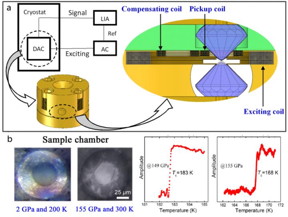Home > Press > Perfect diamagnetism observation of high-temperature superconductivity in compressed H2S
 |
| (a) Simplified flow chart for the magnetic susceptibility measurement set-up for the diamond anvil cell (DAC). LIA and AC denote lock-in amplifier and alternating-current source, respectively. (b) Left: The sample in the gasket hole at 2 GPa and 200 K (left), and at 155 GPa and 300 K (right), respectively. Right: Magnetic susceptibility signals of sulfur hydride at various pressures. CREDIT ©Science China Press |
Abstract:
The discovery of the extremely high superconducting temperature (Tc) of ~200 K reported in the sulfur hydride system above 100 GPa, has broken the high-temperature superconductivity record for the copper oxides. The zero resistance superconducting measurements of sulfur hydride system have been reported by Eremets et al.. Direct, complete and many pressure-point Meissner effect measurements under high pressures are urgently needed. Motivated by this, the research group of Prof. Tian Cui from Jilin University has made a breakthrough in fulfilling the perfect diamagnetism of sulfur hydride system under high pressure, using a highly sensitive magnetic susceptibility technique adapted for a megabar-pressure diamond anvil cell (DAC).
Perfect diamagnetism observation of high-temperature superconductivity in compressed H2S
Beijing, China | Posted on June 14th, 2019Through theoretical calculation and experimental research, scientists have found that some hydrogen-rich compounds show very high superconducting transition temperature under high pressure. For example, the superconducting transition temperature of sulfur hydride at 155 GPa is 203 K, and that of lanthanum hydride at 170 GPa is 250 K. However, the experimental studies on the superconductivity of hydrogen-rich compounds are focused on the characterization of the superconducting zero resistance characteristics. As is known to all, perfect diamagnetism is another essential characteristic of superconductors, but the experimental measurement of perfect diamagnetism in hydrogen-rich compounds at ultra-high pressure is extremely challenging. Megabar presures or even higher can be generated by the diamond anvil cell, but the sample size is less than 0.05×0.05×0.01 mm3. The very small sample dimension and sensitive metal parts of the cell lead to very low signal-to-noise ratio when performing magnetic measurement, so it is very difficult to extract weak sample signals from huge noise signals.
By suppressing the noise of signal source, shielding the transmission noise and improving the sensitivity of signal extraction, the authors optimize the magnetic measurement method based on DAC, build the magnetic susceptibility measurement system with high sensitivity, and measures the alternating current magnetic susceptibility of sulfur hydrogen sample under high pressure. They firstly sealed liquid hydrogen sulfide into a DAC using cryogenic technology. The target sample H3S was prepared by low temperature compression path and the superconducting transition was observed at 183 K and 149 GPa. The trend of superconducting transition temperature under different pressures was obtained, and the superconducting phase diagram of hydrogen sulfide was improved.
The research results show that it is feasible to measure the alternating current susceptibility in the hydrogen-rich compounds above megarbar pressure. The above research confirms the high-temperature superconductivity and determined the superconducting phase diagram of sulfur hydrogen system from magnetic susceptibility data, which opens up a broad research prospect for the experimental research of hydrogen-rich superconductors under ultra-high pressure.
####
For more information, please click here
Contacts:
Tian Cui
Copyright © Science China Press
If you have a comment, please Contact us.Issuers of news releases, not 7th Wave, Inc. or Nanotechnology Now, are solely responsible for the accuracy of the content.
| Related Links |
| Related News Press |
Superconductivity
News and information
![]() Researchers develop molecular qubits that communicate at telecom frequencies October 3rd, 2025
Researchers develop molecular qubits that communicate at telecom frequencies October 3rd, 2025
![]() Next-generation quantum communication October 3rd, 2025
Next-generation quantum communication October 3rd, 2025
![]() "Nanoreactor" cage uses visible light for catalytic and ultra-selective cross-cycloadditions October 3rd, 2025
"Nanoreactor" cage uses visible light for catalytic and ultra-selective cross-cycloadditions October 3rd, 2025
Possible Futures
![]() Spinel-type sulfide semiconductors to operate the next-generation LEDs and solar cells For solar-cell absorbers and green-LED source October 3rd, 2025
Spinel-type sulfide semiconductors to operate the next-generation LEDs and solar cells For solar-cell absorbers and green-LED source October 3rd, 2025
Discoveries
![]() Researchers develop molecular qubits that communicate at telecom frequencies October 3rd, 2025
Researchers develop molecular qubits that communicate at telecom frequencies October 3rd, 2025
![]() Next-generation quantum communication October 3rd, 2025
Next-generation quantum communication October 3rd, 2025
![]() "Nanoreactor" cage uses visible light for catalytic and ultra-selective cross-cycloadditions October 3rd, 2025
"Nanoreactor" cage uses visible light for catalytic and ultra-selective cross-cycloadditions October 3rd, 2025
Announcements
![]() Rice membrane extracts lithium from brines with greater speed, less waste October 3rd, 2025
Rice membrane extracts lithium from brines with greater speed, less waste October 3rd, 2025
![]() Researchers develop molecular qubits that communicate at telecom frequencies October 3rd, 2025
Researchers develop molecular qubits that communicate at telecom frequencies October 3rd, 2025
![]() Next-generation quantum communication October 3rd, 2025
Next-generation quantum communication October 3rd, 2025
![]() "Nanoreactor" cage uses visible light for catalytic and ultra-selective cross-cycloadditions October 3rd, 2025
"Nanoreactor" cage uses visible light for catalytic and ultra-selective cross-cycloadditions October 3rd, 2025
Interviews/Book Reviews/Essays/Reports/Podcasts/Journals/White papers/Posters
![]() Spinel-type sulfide semiconductors to operate the next-generation LEDs and solar cells For solar-cell absorbers and green-LED source October 3rd, 2025
Spinel-type sulfide semiconductors to operate the next-generation LEDs and solar cells For solar-cell absorbers and green-LED source October 3rd, 2025
![]() Rice membrane extracts lithium from brines with greater speed, less waste October 3rd, 2025
Rice membrane extracts lithium from brines with greater speed, less waste October 3rd, 2025
|
|
||
|
|
||
| The latest news from around the world, FREE | ||
|
|
||
|
|
||
| Premium Products | ||
|
|
||
|
Only the news you want to read!
Learn More |
||
|
|
||
|
Full-service, expert consulting
Learn More |
||
|
|
||








